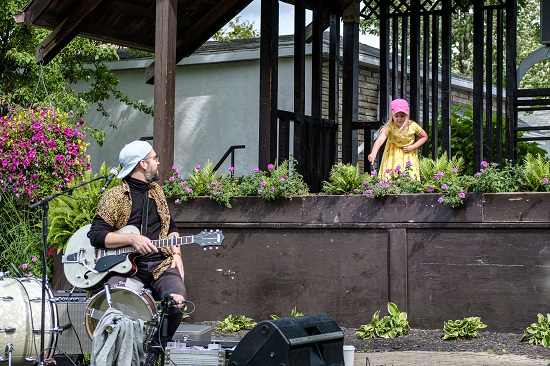Photo by Mat Vezio
Le Festival de musique émergente, FME, is a hard place to get to. The four-day event, designed primarily to showcase Quebecois talent, is situated in the town of Rouyn-Noranda, 10 hours’ coach ride from Montreal. Long, straight highways sprawl forever into the wilds, the roads lined by impenetrable pine forests, jagged cliffs and glistening bodies of water. Only the occasional farmhouse or truck stop breaks the beauty that hurtles past as you travel onwards, onwards and onwards some more. The realisation that in the time it would take to cross most of Britain you’ve traversed a mere fraction of the Canadian countryside, is almost disappointing.
Established when the two mining communities of Rouyn and Noranda merged in 1986, the first you see of the town, population 40,000, is the twin towers of its copper smelting plant. They loom over rows of charming detached houses of which no two are alike, most raised off the ground in preparation for the thick snow that will arrive in winter. It’s a fairly ordinary small town, aside from the large lake on its North East side, not the prettiest, especially compared with the expanse that surrounds it, but not the ugliest either. It is a pleasant place, but is completely transformed for four days of every year by FME.
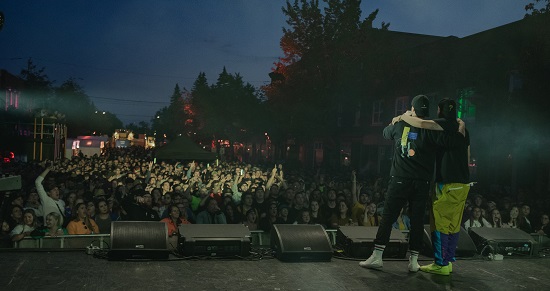
FouKi, photo by Dominic McGraw
The festival is ‘industry-focused’, like SXSW, Iceland Airwaves or The Great Escape on a smaller scale, with a sizeable pack of journalists and industry figures from Belgium to Brazil enjoying lavish treatment. SiriusXM, the key sponsors, have their branding just about everywhere. That said, the locals’ wholehearted embrace of the festival gives it plenty of soul; on one miscellaneous street far from any music, a local antiques store has the festival’s logo chalked proudly onto its window.
The festival was founded by Jenny Thibault, Pierre Thibault (no relation) and Sandy Boutin, who grew up here. “We were tired of going to Montreal and Toronto to see big shows, we were stuck with the music that was playing on the radio and the television,” Jenny tells us over a drink in the picturesque music school temporarily taken over by the media for their base. “It was for us a way to bring good music to our own place, instead of travelling.”
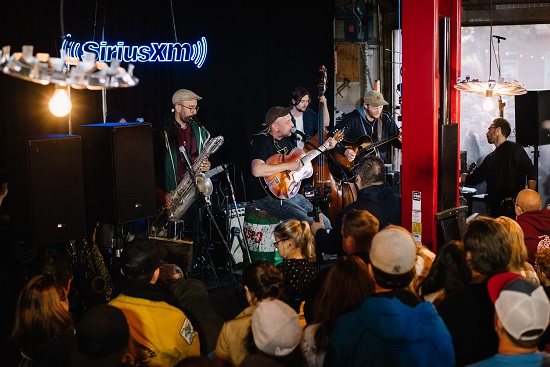
Bernard Adamus, photo by Christian Leduc
When things are in full swing, the suburban streets on Rouyn-Noranda’s outskirts are almost silent, the entire population gravitating towards the festival’s hub. The main outdoor arena takes up an entire residential street. “The local people like to feel like they own the festival,” says Jenny. “I think the people from this region are very collaborative. They’re isolated in this small city so they need to be cooperative with their neighbours. They need to have relationships with their community. It’s the biggest event of the year for all the restaurants, the taxis, it’s bringing money and tourists to the town. We have the DJs playing outside until 3am, and we’ve never received any complaints.”
On one of the city’s main streets, a petrol station has been converted into the SiriusXM Garage, one of the key venues. It hosts a free gig every day. The first is by blues-rocker Bernard Adamus, the second by folk-rock singer-songwriter Marie-Pierre Arthur, and the third by chameleonic master of chanson Émile Bilodeau. All three are relatively unknown outside of French-speaking Canada, but are huge in Rouyn-Noranda, and it’s more or less impossible to get inside the garage itself. The crowd spills over onto the streets outside as music filters out onto the pavement, where it has the air of a locals’ get-together, the kind you only get in a small town. As the industry pack melds into a diverse mix of old and young, families with their babies and their dogs, the cynicism that so often comes along with a ‘showcase’ gig quickly disappears, community spirit overpowering the corporate branding. In a car park around the corner, a record label hosts their traditional tailgate party. They might only be here to flog their brand, and the music on the boombox isn’t all that, but what does that matter when it’s this much fun?

Doiron-Placard, photo by Dominic McGraw
Next door to the garage, up a steep stairway, is L’agora des arts, a church converted into a community theatre. Inside is where the majority of the weekend’s best music takes place, including La Force, who delivers the finest set of all. The pseudonym of Broken Social Scene’s Ariel Engle, her music is complete and unique, confident pop backed up with sublime synth and driving bass, packed with glistening, launching choruses. Chilean trio LA Julia Smith are one of a handful of bands invited from outside North America, and take inspiration from the disastrous 2010 earthquake, 8.8 on the Richter Scale, that hit their home city of Concepción. Also in the theatre, to begin they unfurl dark and fiery riffs, a propulsive heavy-psych pummelling of the highest order, before switching instruments and becoming another band entirely. Before our eyes, they transform into an indie synth-pop group, the smooth polar opposite to their bruising alter-ego. Then, they swap again, and sit somewhere between the two. It’s a set of peaks and troughs – the heavier they are, the better – but nothing if not engaging.
Also at L’agora des arts, Julie Doiron (formerly of cult Moncton lo-fi outfit Eric’s Trip, and now an accomplished folk singer-songwriter) and Dany Placard (an acclaimed figurehead of Quebec’s prominent folk-rock scene) team up as Doiron-Placard for a special acoustic set, trading each other’s songs. The gig is steeped in mutual admiration, and serves both as a demonstration of their shared prowess as musicians and a winsomely intimate live performance. Even better is Doiron’s solo performance two days prior, one of the festival’s many ‘surprise’ shows, announced last-minute and signposted with sandwich boards dotted around the city. It takes place at the tiny, beautiful Russian Orthodox church nestled in Rouyn-Noranda’s suburban streets, where Doiron stands in front of an ornate golden edifice. There’s a hint of her grunge origins, plenty of grit and character to her deft acoustic guitar work. The crowd, some sat cross-legged on the church tiles, are silent and enraptured while she plays both in English and French, you can hear the click of her guitar pedal before she turns on the fuzz.
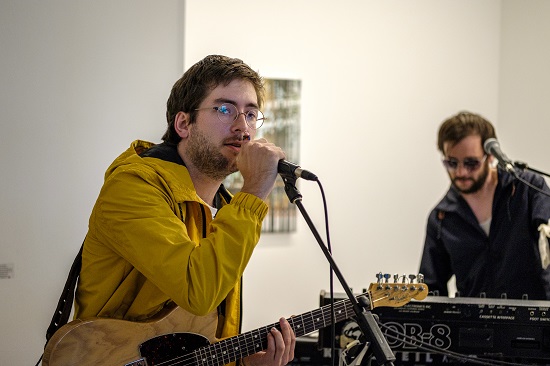
McClean, photo by Dominic McGraw
It’s these secret sets, away from the hubbub, that form some of FME’s most lasting impressions. They spring up everywhere you walk, in the library, the restaurants, the park and the local shops. In years past, the town’s supermarket even started hosting gigs in its aisles. In the basement of gastro-pub Le Groove we once again bump into LA Julia Smith’s genre-hopping mania, while walking past a small local art gallery we spy Mclean, bespectacled and at first unassuming, gearing up to deliver a passionate, melodramatic set of sharp indie pop that defies first impressions.
It is FME’s outdoor arena, however, a large stage erected at the end of a closed-off residential street that provides the truest indication of where Quebec’s youth are channelling their creativity. The majority of the billing there is hip-hop and trap, the majority of the crowd are teenagers, and the result is a riotous hub that bristles with energy. Rappers virtually unknown in Britain like the multi-award winning Koriass – whose slick, G-Funk inflected single ‘Cinq à sept’ dominated Quebec radio throughout 2018 – garner the reception of megastars. Rising Montreal rapper Sarahmée is the best of the bunch, her presence ferocious and her beats brimming with flair, while the six-piece Alaclair Ensemble are irresistibly joyous, peppering their set with a welcome helping of late-90s boyband dance moves.
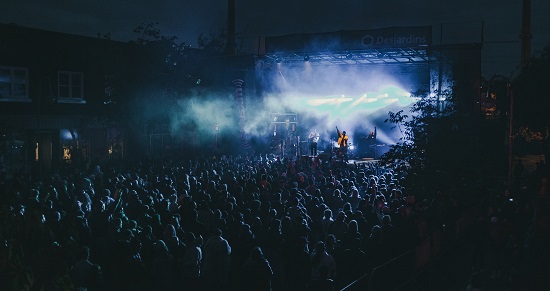
Sarahmée, photo by Dominic McGraw
On the last day the arena is opened to the public, with DJs taking over the outdoor programming. Gathering down the road is Rouyn-Noranda’s sizeable metal community, arriving en masse for an evening of heavy music hosted at a small attic venue tucked away at the side of the road, Le Petit Théâtre du Vieux Noranda. It begins with Archon, a death metal outfit formed in Rouyn-Noranda a decade ago. The locals’ sense of civic pride shines through once again, albeit in the form of a brutal circle pit that engulfs half the room as Archon roar through a breathless half-hour set. Necrotic Mutation, stalwarts of Quebecois metal since their formation three decades ago, their frontman arriving in a straightjacket, follow and are more incendiary still, before Deathcore veterans Despised Icon light the final fuse of the festival, an explosive, ludicrous conclusion to the most enjoyable evening of all.
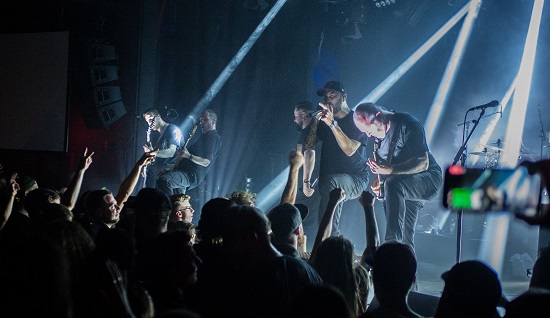
Despised Icon, photo by Thomas Dufresne
Nights like these, celebratory for the sake of the music, not for enhanced prospects of an appearance on a ‘Sound of 2020’ poll, are the sort that so often go overlooked at ‘industry’ festivals, and are indicative of the heart and soul that makes FME so special. For all the showcase gigs, branding opportunities and buttering up of business types, it is the local people of Rouyn-Noranda whose spirit shines through – whether old-time metalheads, trap-obsessed teenagers or a shopkeeper reaping the benefits of increased business. Rarely does an inner-city festival feel so entwined with its local community, each giving so much to the other to make an event even greater than the sum of its parts.

